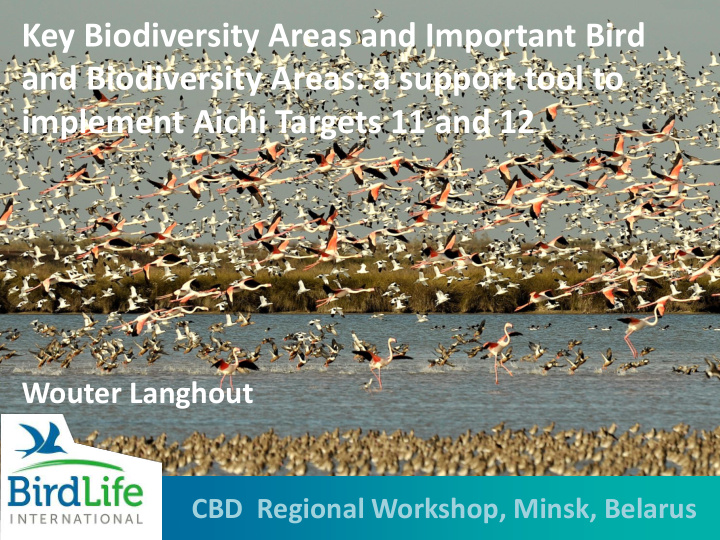



Key Biodiversity Areas and Important Bird and Biodiversity Areas: a support tool to implement Aichi Targets 11 and 12 Wouter Langhout CBD Regional Workshop, Minsk, Belarus
Important Bird and Biodiversity Areas (IBAs) – The IBA Programme started in Europe in the late 1970s – IBA global criteria are based on: • Threatened species, Restricted-range species, Biome-restricted assemblages, Congregations – In Europe, also regional and sub- regional (EU level) criteria – The IBA network captures a large proportion of species in other taxonomic groups
Global science and local expertise • Data for IBA identification is collected locally and analyzed at the national and regional levels • IBAs are identified using the global or regional IBA criteria in a fully participative way, using expert knowledge • Site information is up-dated using monitoring and other published and unpublished data • BirdLife Partners find it difficult to raise funds for monitoring and up-dating, both of which are key for the continued provision of high-quality information
Over 12,000 IBAs have been identified globally Terrestrial IBAs cover c. 7% of land surface
Marine IBAs: the marine e-atlas 3000 sites in 150 countries and on high seas – 6.5% of the oceans
AZE SITES: 587 SITES 920 SPECIES
Key Biodiversity Areas (KBAs) • KBAs are sites contributing significantly to the global persistence of biodiversity • The new global KBA Standard was approved in April 2016 and now provides the framework for KBA identification and revision • The KBA Standard has 11 criteria grouped under five categories: Threatened Biodiversity, Geographically Restricted Biodiversity, Ecological Integrity, Biological processes and Irreplaceability through quantitative analysis • A global KBA Partnership will be launched at the IUCN WCC in Hawaii “to implement a programme to develop and maintain an up-to-date, fully documented list of sites identified against the KBA Standard, and to communicate, promote and position this information to enable the achievement of the KBA vision .” • Regional and national KBA criteria may be developed and used (e.g. regional IBA criteria)
IBAs and AZE sites as Key Biodiversity Areas • ALL IBAs are KBAs for birds at the global or regional level • ALL AZE sites are also KBAs • In selected regions it was found that the majority of KBAs identified to date are IBAs • IBAs will need to be re-assessed against the global KBA criteria within the next 8-12 years
KBAs including IBAs and AZE sites need better protection Terrestrial IBA protection: By area: 39% covered by national PA networks By number: 28% of IBAs completely covered by PAs 49% of IBAs are wholly unprotected
Approximately 60% of AZE sites identified so far are protected today. We need 100% or c. 230 more sites protected by 2020 to meet the CBD Aichi Targets.
Progress towards Target 11 Temporal trends in mean percentage area IBAs (green) and AZEs (violet) covered by PAs.
IBAs are a basis for PA gap analysis
Protected IBAs are in better shape Annual % change in Red List index Extinction risk of birds is lower in better protected IBAs (Butchart et al . PLOS One 2012). Coverage by Protected Areas But as PA network grows, proportion of PAs covering IBAs is falling.
IBA identification & SPA designation in EU Nearly 47 million hectares of IBAs are now protected within the Natura 2000 network of protected Areas
IBAs have many other applications… … for Target 11, Target 12 and other Aichi Targets
Informing EBSA description Over 600 IBAs have so far been included within EBSAs
Supporting Ramsar site designation Important Bird Areas and potential Ramsar Sites in Europe
Safeguards and mainstreaming biodiversity
Promoting local engagement with conservation Local Conservation Groups or IBA Caretakers are at over 2,700 IBAs around the world
Thank you…
IUCN Iguana Specialist Group International International Iguana Foundation Iguana Foundation World Pheasant Association World Pheasant Association
Recommend
More recommend